Down Syndrome BLW Success Stories with @ableappetites Sabrina Smiley Evans, MS, CCC-SLP
- Their personal and successful experience with baby-led weaning and their son Graham who has Down syndrome
- Typical feeding challenges that children with Down syndrome encounter
- Recommendations for parents who face push-back within their medical team in regards to baby-led weaning
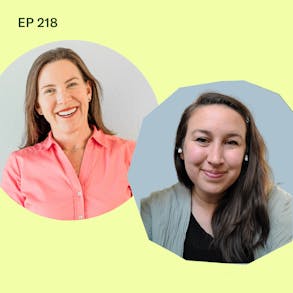
LISTEN TO THIS EPISODE
Episode Description
What are some feeding challenges for babies with Down syndrome? Can baby-led weaning work if my baby has Down syndrome? In this episode speech-language pathologist Sabrina Smiley Evans, MS, CCC-SLP is joining me to discuss some of the feeding challenges that babies with Down syndrome may encounter but also the ways in which parents and caregivers can moderate and create a safe environment for these babies to successfully accomplish baby-led weaning and become independent eaters.
About the Guest
- Sabrina Smiley Evans, MS, CCC-SLP is a speech-language pathologist specializing in early intervention, Autism, and sensory-based feeding disorders.
- She is a mom of three-year-old Graham who has Down syndrome and successfully did baby-led weaning when starting solids
- Sabrina, along with Sara Quirk run the Instagram account @ableappetites which features children with Down syndrome who are learning to become independent eaters

Links from this Episode
To follow and learn more about the work that Able Appetites does:
- FOLLOW on Instagram @ableappetites
- Baby-Led Weaning with Katie Ferraro program with the 100 First Foods™ Daily Meal Plan, join here: https://babyledweaning.co/program
- Baby-Led Weaning for Beginners free online workshop with 100 First Foods™ list to all attendees, register here: https://babyledweaning.co/baby-led-weaning-for-beginners

Latest Episodes
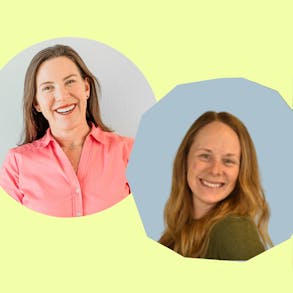
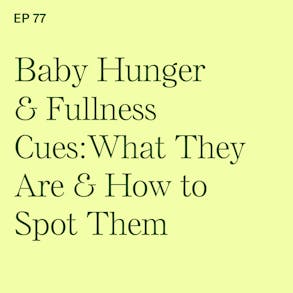
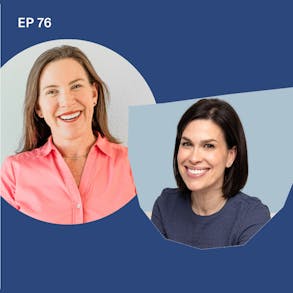
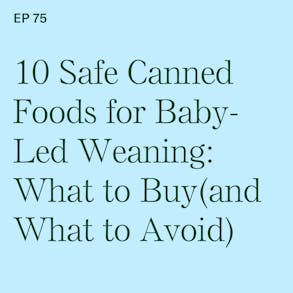
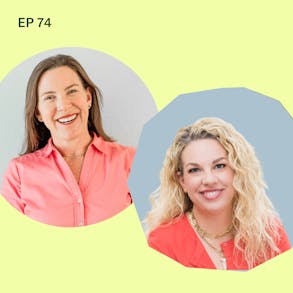
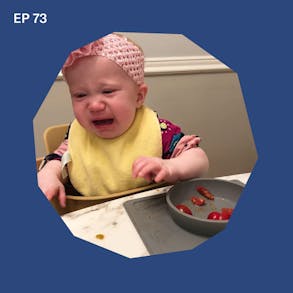
Sabrina Smiley Evans (1s):
A lot of children with down syndrome tend to have high arch palette. And that's something that actually baby meaning might potentially help with jaw shape and palette shape eventually.
Katie Ferraro (12s):
Hey there I'm Katie Ferraro Registered Dietitian college nutrition professor and mom of seven specializing in baby-led weaning here on the baby-led weaning made easy podcast. I help you strip out all of the noise and nonsense about feeding, leaving you with the competence and knowledge. You need to give your baby a safe start to solid foods using baby-led, weaning. Hello, and welcome to this episode about babies with Down syndrome and how they can do a baby Led Weaning. And my guest today is Sabrina Smiley Evans. She is a speech-language pathologist. She is the mom of a son named Graham. Who's three years old. Now Graham has down syndrome and they did baby Led Weaning with Graham and Sabrina, along with her colleague and friend Sarah, they run the Instagram account, Abel appetites.
Katie Ferraro (1m 2s):
And so Abel appetites features children with Down's syndrome learning to become independent eaters. I'm so excited that Sabrina's on because I've been familiar with her page and her baby and her situation for two and a half years, she actually reached out when she wanted to start solid foods with Graham, she did baby Led Weaning. It looked a little different than maybe Led Weaning might look for a neuro-typical children, maybe for your child, but for those of you who are listening because you have a child or you work with children who have down syndrome, Sabrina has a really important message, which is how you can help your child achieve independent eating and independence using baby Led Weaning even if they have Down Syndrome.
Katie Ferraro (1m 42s):
So I'd been putting this episode together for a while. We actually had Jill Raven on a while back. Jill Raven is a speech language pathologist who created the adapted approach to baby Led Weaning. She was on an episode 198, talking about adapted baby LED WEANING for feeding challenges and Jill who is working on a book right now with Gill Rapley, who was the original founding philosopher of the whole baby led weaning movement. And the author of the original baby led weaning book, Gill Rapley and Jill Raven were working on this book about adapted baby Led Weaning. We're talking about Down Syndrome. And I had asked Jill Raven to do an episode about Down Syndrome. And she's like, no, no, no, no, no. You've got to have Sabrina from Ableappetites do it. So this is the first time we actually met in real life in this interview. And I could have talked to her for hours, but we had to cut it down, but there's still some very, very valuable information in there.
Katie Ferraro (2m 26s):
And what I hope you will listen to is kind of the takeaway message that there is this list. It's not a formalized list, but for those of you who work in feeding, there's a list of diagnoses or feeding challenges where you'll see baby-led weaning might not work for, and then lists all of these conditions or these diagnoses. And my intention with my platform and with this podcast is to highlight that while certainly not all children can do baby-led weaning exactly the same. No two babies do anything the same. I do want to highlight the success stories of families who have had experiences learning how to do solid foods using the baby-led approach. And again, it might look very different. That's the whole point of Jill Raven's adapted baby-led weaning approach so that we can stop spreading the myth that oh, well, all children with down syndrome will always need to be spoonfed by their parents because certainly that's not the case.
Katie Ferraro (3m 15s):
So I think with Sabrina, having the background as a speech-language pathologist and her background in early child development, she really brings a unique perspective in addition to being a mom of a child with down syndrome, who did baby led weaning. So with no further ado, I want to introduce you guys to Sabrina Smiley Evans. She is the co-founder of the able appetites Instagram page. And we're going to be talking about down syndrome, baby Led, Weaning success stories.
Sabrina Smiley Evans (3m 41s):
Thank you so much for having us Katie. It's such a pleasure. And I don't know if I told you this, but when Sarah and I were getting started doing baby Led Weaning, you were one of our primary sources. Oh, as at the time, there was not very much out there. You know, even though it was just whatever two and a half years ago, you were one of the primary sources that we used on Instagram and the way that you presented a variety of different texture options for different foods was incredibly helpful.
Katie Ferraro (4m 9s):
Well, thank you. And I noticed you guys to my account, you guys tagged me a ton and I was like, wait, this is so interesting because I was explaining a little bit before we started the recording, that one of our overarching goals is to really help dispel this notion that there's a laundry list of conditions or diagnoses of types of babies who can't do baby Led Weaning. So occasionally you'll see things on less well-informed sites or outlets that will say things like babies with lip ties or tongue ties. Can't do it. If you have a cleft palate, you can't do baby Led Weaning. If your baby has down syndrome, you can't. And so if you've noticed through our content little by little, we're just trying to dispel those myths by highlighting families who are doing baby Led, Weaning, maybe it looks different.
Katie Ferraro (4m 50s):
And we've had Jill Raven on the podcast talking about her adapted baby-led weaning approach. She works with children with down syndrome. And I know you guys are familiar with her work. We originally were going to do a Down Syndrome episode with Jill Raven. She's like, no, no, no, no, no. You need to talk to Sabrina from Abel appetites. And I was like, yes, this is the opportunity. Cause I'd been really familiar with your guys' work. So before we dive into questions about Down Syndrome and baby Led Weaning, could you just tell us a little bit about your background, both as a professional and the parent?
Sabrina Smiley Evans (5m 15s):
Absolutely. So I'm a speech-language pathologist. I graduated from Vanderbilt a long time ago and I had been primarily focusing on early intervention, autism and feeding. So a lot of my feeding experience had been more in the sensory-based realm and helping children with autism, but I had a relatively diverse early intervention caseload as well. And one of the things that I noticed as I was helping these children learn how to eat was that what their parents were offering them from the beginning was making a huge difference in what they would accept later on whether or not they became picky eaters, whether or not they were willing to try different things regardless of their diagnosis.
Sabrina Smiley Evans (5m 57s):
And I had a friend, you know, this is how it always begins, right? You have a friend who is trying this cool new thing called baby-led weaning, and started to follow along and was really interested in using that for my son Graham. So my son Graham is now three years old and he has down syndrome. I have some allergies and I was worried that he may experience some of those same food allergies. You know, we don't want to put our stories on our children, but at the same time, we want to be aware of the things that we've experienced so that we can kind of help support their development. And so I really wanted to be able to have more control over what types of food I offered him to be able to keep a really good log of how he responded to those different foods.
Sabrina Smiley Evans (6m 41s):
And baby LED WEANING allows for you to do that at a much greater degree and still include a lot of really healthy, wonderful foods without feeling limited. And then at the heart of what we're doing with Able appetites is also the fact that we really would like for all children to feel included in their families. And one of the best ways we can do that is for them to be included in the family meal, which baby Led Weaning allows you to do at a far greater degree than having a separate meal plan for you.
Katie Ferraro (7m 11s):
So Able appetites your online community, your Instagram page. Give us the background on that. How did you get connected with Sarah? What is your guys' intention there? What's your plan for able appetites and for the audience members who maybe aren't familiar with Able appetites, what is it that you guys do?
Sabrina Smiley Evans (7m 26s):
So Sarah cork and I met via the Down Syndrome diagnosis network when Graham and Cleo were just babies. So they were around three and four or five ish months old. And Sarah asked if anybody else was interested in doing baby-led weaning with their child with down syndrome. And I was so excited because it was something that I wanted to do, but felt fear around doing even a speech-language pathologist who had helped many other kids on their feeding journey. And so I was like, pick me, I need someone else to speak with about this. So we became each other's support system and looking at resources and ways that we could adapt as Jill Raven talks about ways that we could adapt baby-led weaning to allow our child to have access to that family meal.
Sabrina Smiley Evans (8m 14s):
And now we have this platform that we're running on Instagram called able appetite, which is supposed to be a community resource for families that have children with down syndrome. But we don't discriminate against numbers of chromosomes. All chromosome amounts are welcome and we try to provide resources and help families find the things that helped us as well.
Katie Ferraro (8m 36s):
So you're there as a resource for parents, especially I know for parents of children who have down syndrome, it's so disheartening for me, especially as an expert in baby-Led Weaning. I know that they feel this way when they see, oh, there's this list of things that, you know, babies with Down syndrome can't do. And one of them is maybe feed themselves, oh my gosh, is my child gonna be dependent? Or are they going to be tube dependent? Am I going to have to spoonfeed them forever? And so thinking about the power of Instagram and power of video, right? Like no one can tell you, well, babies with Down syndrome, can't do baby-Led Weaning because there's Graham learning how to feed himself. So that resource is available, which is wonderful. But I'm wondering if you can take us back to the time when Graham was approaching six months of age and with an SLP background, you were like, okay, developmentally, he could be getting ready to start solid foods.
Katie Ferraro (9m 19s):
Did you feel supported outside of the connection you had with Sarah? Did you have practitioners telling you you could or could not do baby Led Weaning? Did you feel like you had to figure it all out on your own what was happening at Graham six month mark?
Sabrina Smiley Evans (9m 32s):
So I definitely felt alone. I think that most of the providers that we were working with were frankly too afraid to tell me that he couldn't because I was like super determined that he could, if that makes sense. So they weren't going to burst my bubble about that, but they gave me some things that they felt like he needed to be able to do. First. One of which was that he needed to be able to cross midline and, you know, needed to be able to sit unsupported. And while I know that those things can be really beneficial. I worked with the team that we have as far as his physical therapist and an occupational therapist, friend of mine. And then I did a bunch of research and deep diving into the things that I could find.
Sabrina Smiley Evans (10m 17s):
There was one blog post from a fellow mom of a child with Johnson who had done baby LED WEANING. And there was Jill Raven's presentation. It was one of the first that she had done. She said, I think for, I don't know, maybe the university of Arkansas and there were slides and Sarah and I just gobbled up all of the stuff to help ourselves prepare. And in a way our experiences were the same, but also different because Sarah has two older children that are older siblings to Cleo. And so she already had experienced. And so I think that was actually a little bit more fearless sometimes in what she offered her. And I was more likely to adapt things, but Graham and Clea are also just different kids. So Graham also had a tongue tie release.
Sabrina Smiley Evans (10m 59s):
And so there were a few things that I had to look out for and accommodate. So things like black beans, the skin on black beans, even if cooked until they were soft, would be more likely to get stuck in his palette. A lot of children with downs syndrome tend to have high arched palates, and that's something that actually might potentially help with Josh shape and palette shape eventually. But I would have to check his mouth to make sure that he didn't have any beans, skins stuck in his palette at the very, very beginning stages when he was six and seven months, because we'd were able to start at six months, we felt like he was safe in a supported seat. We have the AB high chair, but I know that there are several others that we like.
Sabrina Smiley Evans (11m 40s):
I know that you guys have sometimes have that featured the Nomi chair, which looks amazing. And in his supported seat, he looked really great. He was able to control his respiration and also bring foods to his mouth really quickly with scaffolding. So we talk a lot about teaching them to be independent from the beginning and not dependent upon us because they need a little extra motor practice. So the idea of doing baby-led weaning sometimes also gives them that additional motor practice. So by the time they're between nine and 12 months, when you want them to be eating more volume, they're ready. And you're not waiting until the point when they're closer to 12 months and maybe they feel like they don't want you to feed them, but they don't have the skills yet because they haven't been practicing them.
Sabrina Smiley Evans (12m 23s):
So he was able to hold onto his own little utensils and bring them to his mouth. We started with handing at midline and then I would have him follow my hand down to the edge of the tray so that he knew how to pick it up from the tray where it was resting on a silicone plate. You know? So it had a little bit of an edge for him to grab
Katie Ferraro (12m 41s):
About cup drinking. Did you guys start with open cup drinking and I kind of forgot to ask, but what was the infant milk situation with Graham up until you started solid foods?
Sabrina Smiley Evans (12m 50s):
Yeah, we were really lucky and he was able to be an exclusive breastfeeding until
Katie Ferraro (12m 56s):
Mouth just so amazing. We could probably do a whole separate episode on breastfeeding your baby with down syndrome, but congratulations,
Sabrina Smiley Evans (13m 4s):
Thank you. And you know, Sarah and Cleo were able to achieve that too. And we have more stories everyday because people like Julia's way and Jill, Raven are getting the word out that it is absolutely possible for your child with down syndrome to breastfeed. And, you know, we know that not everyone will always be able to achieve that, but if that's a goal of yours and it's something you want to work on, it is absolutely a great thing to try to do. And I really appreciated the time that we had to do that and to bond and for, to nurture him in that way. But an answer to your question. So I prefer to start with an open cup as an SLP because the liquid and a straw moves really quickly. And so a tiny cup, like the EzPz tiny cup, or I use the nosy cup because I was unaware of the EzPz product line at that point in time though, I really wished that I had been aware of it because they all look amazing.
Sabrina Smiley Evans (13m 56s):
So starting with that, just a small one ounce amount of liquid is what I prefer to do. And so Graham was practicing drinking from an open cup once a day. And I used water that, you know, Dawn has changed my mind.
Katie Ferraro (14m 8s):
It's so funny cause we don't do water generally for babies up until it close to like 10 months of age for neuro-typical children. She doesn't love it because of a thin liquid and is a little bit more challenging, but you know, you're in SLP. So, and again, trust your mom, got, you guys know your baby's best, but like there are definitely some babies who struggle a lot on thin liquids. And so working with infant milk, be it breast milk or formula can be easier. I don't love water early on because it takes up very valuable room in a baby stomach. It can make them feel artificially full at which point we're interfering with that feedback loop, especially for older babies, they are at the point where they can start listening and responding to their hunger and fullness cues. I don't want them to be pumped full of water and be like, oh, I'm not hungry and then not eat food. So Dawn and I are kind of, it's funny, we don't disagree on that, but we agree with water later for different reasons.
Katie Ferraro (14m 48s):
And that's coming from, you know, your own professional background. You're an, I'm a dietitian.
Sabrina Smiley Evans (14m 52s):
You guys have both convinced me that using a source of milk is a way better option, especially for children with down syndrome or children who may have differences in motor tone because, and I just did not realize this, you know, we learn new things all the time, but it's upwards of 60 to 70% of babies with Down syndrome, silently aspirate. So, so it's a really high number and starting with the liquid, which is usually the prescription. If you come up with aspiration is just going to increase their success. So if you've got those containers of purees, that's an excellent way to use the,
Katie Ferraro (15m 27s):
I mean the open cup. Absolutely. You don't need to go by like thicket and make your own second water like you were in a nursing home or something, but there are thicker liquids. We had do a coconut milk with a baby. I was working with some, had had some low tone issues and she just did better drinking plain coconut milk. It doesn't have to be super fancy. It was just thicker than water.
Sabrina Smiley Evans (15m 44s):
And sometimes the flavor too, you know, has an alerting component so that they pay attention a little bit more to where their articulators and oral musculature is going. But at the time as a mom, I was like, I do not want to go back to a breast pump if I never,
Katie Ferraro (16m 1s):
I know that's the problem. A lot of moms that breastfeed are like, I'm not wasting. And then some moms are open. Like, listen, I'll try formula. I'm like, listen, we can also try purees. We can try. I mean, there's different ways to do thicker liquids. It doesn't have to be you wasting your valuable breast milk. I get that. So Sabrina, I want to ask now about what are some of the typical feeding challenges and you mentioned some of them, but that for parents of children who have down syndrome, things that they should look out for, maybe that the timing would be a little bit different than a neuro-typical child or some of the things regarding the palette or the motor skills that might put them on a different timeframe for baby-Led Weaning, but certainly are not things that are insurmountable.
Sabrina Smiley Evans (16m 37s):
So the really big overarching one for most children with down syndrome is low tone that inability to keep all their muscles activated and working in the way that they would like to, it doesn't necessarily mean that they're not strong and you'll often see them even meet milestones on time. Graham met a lot of his motor milestones, but the problem was he wasn't doing it as much or holding it for as long as his neuro-typical peers. So that's a core one because you do need some of that core strength and the arm strength and the hand-eye coordination in order to feed yourself at the table. But feeding allows for a lot of great opportunities to also strengthen those muscles.
Sabrina Smiley Evans (17m 19s):
So what we say for the most part is to talk to your team. So you need to talk with your team check and make sure that they have the reflexes that you would want them to have. Do they have a gag reflex? Do they have lateralizing reflex? Are they able to both breathe and sit in their chair in a supported fashion? Because recreation is always going to come first and have your physical therapist or your occupational therapist help with positioning because hopefully, especially during this early intervention period, you're going to have a little bit more and then other things to look out for are it's more common to have allergies, especially to dairy, I believe. And from what I've read, it's more common to have tongue ties or tethered oral tissues from what I've read and then looking out for constipation.
Sabrina Smiley Evans (18m 8s):
So between the low tone and what their diet is, a lot of children with down syndrome, experience constipation, and it's important to rule out some of the more, I don't know, invasive reasons for constipation, such as Hirschsprung's disease, but for most children, it's just a matter of making sure that they have the right fiber and that they are learning how to chew because those digestive enzymes are going to make a huge difference in their ability to digest their food safely. And then of course the silent aspiration, which we were just talking about.
Katie Ferraro (18m 37s):
Okay. But none of the silent aspiration, obviously scary. You're an SLP. You work in this arena. Let's talk about that. You set up rates of 60% of children with down syndrome have silently aspirated. I'm not familiar with that statistic. Not that I doubted it just as like have never heard it. That's a very high percentage that would scare me away from wanting to start solid food.
Sabrina Smiley Evans (18m 55s):
Well, and you know, silent aspiration isn't as much of a concern for foods. Most of the time, it is going to be for thin liquids, which at this point time, like we were talking about their primary nutrition and their primary liquid is going to be a safer liquid, such as a formula or breast milk. So that is a concern. And I would say shade towards thicker liquids. Like we were talking about when practicing with an open cup and I personally prefer to wait until they are more of a functional sitter to work on a straw.
Katie Ferraro (19m 25s):
SLP is who have background in feeding recommend. Okay. And I wanted to mention something to, you said earlier, you know, you're talking about working with your team and you're going to have more support. And I assume you meaning from therapists at the early intervention phase. So you were, I would say probably lucky in a way that you already worked with an OT and you already worked with the PT, but the reality is a lot of those practitioners are not always on board with baby-Led Weaning. They don't understand it. They have misconceptions about it. They don't understand the research that shows that there's no higher risk of choking with baby-led weaning as compared to traditional spoon-feeding provided that parents are educated. And a lot of times they lack the skillset to educate the parents. Did you encounter any therapists who were like, oh no, you should foresee by spoon or where your team mostly supportive or were you like I'm doing this?
Katie Ferraro (20m 10s):
So you better be on board with it. Like what was happening there with the interaction between the therapists
Sabrina Smiley Evans (20m 14s):
By experience is very unique because I hand picked my team are all wonderful and supportive and also am sort of dogmatic sometimes when I want to do something. So I did not encounter any pushback, but I hear every single day practically from families who are hearing that from their pediatrician, from their early interventionists, sometimes from feeding therapists, because you know, there's a lot of controversy right now in the feeding world. People do not agree on all of these things, which is why I can only share what my opinion and my experiences are and feeding. It's one of those things where every single person feeds themselves in some way. And so every single
Katie Ferraro (20m 53s):
Person is an expert.
Sabrina Smiley Evans (20m 55s):
Everyone's an expert in feeding, they've all fed a child practically. And you know, they've also said themselves and everyone wants to tell you something. And I will tell you as a mom of a child with a disability, it is exhausting sometimes to have this many different opinions. So I would say that if it is something that you would like to do, if you need to pick your team, maybe you need to hire Dawn or Jill for consultation so that you know what to ask for specifically reading the things that you need to do, asking people questions, you know, why can't they do that? And then if that person isn't a good fit, then move on. I think that's something that we don't realize when they're little.
Sabrina Smiley Evans (21m 35s):
We think that we just have to take what we've been given and we're appreciative for what we've been given, but that doesn't necessarily mean that that person is the right person for us in this particular circumstance.
Katie Ferraro (21m 47s):
And I love that message too, because you're advocate for your child in all aspects when they can't do it for them and finding the people who are willing to help you. And also with feeding therapy, as a lot of our audience already knows, we do a really, a lot of work to kind of remove the stigma around the word therapy. It freaks parents out. We said, you know, sometimes in as little as one or two sessions, you can get some tips or some exercises from a credentialed feeding expert. So an SLP or an OT who is a feeding therapist who can help your baby get to their milestones, depending upon the disability or the diagnosis. It might be a little bit later than you had wanted or originally anticipated. But your account, your work, your own experience with Graham Sarah's experience with Cleo is really showing that, yes, this can be done.
Katie Ferraro (22m 30s):
It might look a little different or be on a different timeframe. But I just want to say thank you for sharing that because honestly, I just sit on your Instagram page and watch, I love watching all babies eat and it's so uplifting to see a group of babies, babies with Down syndrome, who, if you look at other outlets will say, oh, they'll never be able to feed themselves. And there are certainly cases of babies with Down syndrome who can't feed themselves generally due to other comorbidities. However, I think your story that, Hey, you figured it out and did it gives other parents hope that maybe I can incorporate some of this into my own experience with my own child. So Sabrina tell us where can our audience go to learn more about able appetites?
Sabrina Smiley Evans (23m 4s):
You can find us on Instagram at able appetites. And I will say that, you know, we never pressure anybody about which path they want to take, because there is a lot of trauma and fear that comes sometimes from being in a NICU unit of this. And we don't want anyone to do anything that they feel uncomfortable about, but I think that just the message that all kids are capable. And you know, the more that I watch children with down syndrome achieve different things. I start to wonder, which is the chicken and which is the egg. Are we creating a self perpetuating myth that children with down syndrome, can't do these things by not allowing them to do these things and to not build these skills when they have protective reflexes or is there really, you know, something preventing them.
Sabrina Smiley Evans (23m 45s):
And I'm starting to wonder if that percentage of children that really have something preventing them from succeeding is much smaller than we ever imagined. The way that I look at baby-led weaning is that it is providing an opportunity for safety because we can never predict what a child is going to pick up off the floor and put in their mouth. Is it going to be a bandaid? Is it going to be a piece of mulch? And in my mind, baby-led weaning is giving them the practice and the tools to keep themselves and their airway safe in all environments, regardless of whether it's around food or if it's going to be trialing playground mulch, because what kid hasn't trailed playground.
Katie Ferraro (24m 23s):
Well, thank you so much, Sabrina. I really appreciate your time and for sharing your own personal experience, but also for the work that you and Sarah are doing at able appetites.
Sabrina Smiley Evans (24m 30s):
Thank you so much. And thank you for what you do. Like I said, you made such a huge difference and we're one of the only like resources that we could find at the time. It was a very small select few groups. So we made it to our a hundred foods list by one, and I was very excited.
Katie Ferraro (24m 46s):
Well, I hope you guys enjoyed that interview with Sabrina smiley Evans. If you're not already following Able appetites, please do on Instagram. They're a fabulous resource highlighting babies who have down syndrome who start solid foods with baby-Led Weaning. They show you why it might be a little different, what it might look like, but they're also sharing the stories of these babies transitioning into toddlerhood and to older children. So you can see how your own child with down syndrome or the children that you work with. If you're a therapist or a practitioner, how they might be able to achieve some level of success with a baby-led approach when starting solids. So I'll link up everything and all of the resources that Sabrina shared in the show notes for this episode, which you can find at blwpodcast.com forward slash 218.
Katie Ferraro (25m 29s):
Thank you so much for listening and I'll see you next time.

The Program Baby-Led Weaning with Katie Ferraro
A step-by-step digital program for starting solid foods safely and navigating the original 100 FIRST FOODS™ meal plan with baby-led weaning.
 EXPERT-LED, PROVEN APPROACH TO EATING REAL FOOD
EXPERT-LED, PROVEN APPROACH TO EATING REAL FOOD CONCISE VIDEO TRAININGS TO MASTER BABY-LED WEANING
CONCISE VIDEO TRAININGS TO MASTER BABY-LED WEANING 100 FIRST FOODS DAILY MEAL PLAN WITH FOOD PREP VIDEOS
100 FIRST FOODS DAILY MEAL PLAN WITH FOOD PREP VIDEOS
Baby-Led Weaning for Beginners Free Workshop
Is your baby ready to start solid foods, but you’re not sure where to start? Get ready to give your baby a solid foundation to a lifetime of loving real food…even if you’re feeling overwhelmed or confused about this next stage of infant feeding.
Get baby-led weaning recipes and tips delivered to your email inbox.

